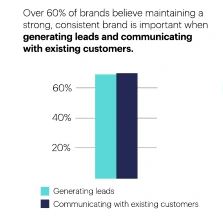As someone who’s been in this business for more than two decades, I’ve worked with countless clients to help revamp their brands.
And after all these years, one of the most common issues I’ve seen (and have had to rectify) is a lack of consistency in branding.
Often, clients who come to us for a rebrand have been doing their own branding or had hired someone who didn’t dive deep enough to develop a strong brand position for them.
Sadly, most of these clients aren’t even aware that there’s an issue with their brand consistency; all they know is that things just aren’t working.
But if more business owners understood the importance of consistency in branding, especially when it comes to their revenue and how consumers perceive their brands, they’d probably be paying a lot more attention to it.
For instance, a Think with Google survey, which polled more than 1,500 U.S. consumers, found that 62 per cent of them “expect brands to deliver a consistent experience”.
So, if you’re not being consistent with your brand messaging, then it’s going to have a decidedly negative effect on how consumers perceive your brand.
And as you can see from the graph below, a survey from Marq, which polled over 450 brand management specialists, found that the majority of them believe that consistency in branding is key when it comes to communicating with customers and generating leads, but I’m surprised that number wasn’t considerably higher.

What’s more, the survey found that these brand managers believe brand consistency has the potential to significantly increase revenue, even by as much as 10-20 per cent.
As you can see from this survey data, consistency in branding is crucial, not just for the way your brand is perceived by consumers, but also when it comes to your profits.
Read: How to Define Brand Identity and Maintain Consistency in All Your Marketing Materials

Before you can maintain consistency in your marketing or your branding, you need to define your brand identity.
Because without that benchmark, you’re not going to have any way to determine if your branding is actually consistent.
So, if you want to ensure consistency in your marketing efforts, but you’ve yet to define your brand identity, then this article will tell you everything you need to know, including how to create a style guide and apply that to various aspects of your marketing.
Why Is Consistency in Branding So Important?
When it comes to your messaging, consistency in branding is crucial, as it helps to reinforce your brand identity, build trust with customers, ensure a cohesive brand experience across all platforms, and support the overall effectiveness of your marketing strategies, among other benefits.
Let’s explore some of the reasons why consistent brand messaging is so important.
Brand Recognition
Consistent use of formatting, writing style, tone, and messaging helps consumers to easily recognize and remember your brand. And when your brand is easily recognizable, it’s a lot easier for it to stand out in a crowded marketplace.
Trust and Reliability
When your messaging and brand presentation are consistent, it helps build trust with your audience, as it makes you look more knowledgeable, reliable, and professional.
When you consistently communicate things like your values, what you can do for potential clients, or your unique differentiators, consumers will be more likely to trust your brand and want to give you their business.
Clear Brand Identity
A consistent brand message helps to establish a clear identity and personality for your brand.
This clarity allows your brand to communicate its values more effectively, as you’ll avoid waffling, contradicting yourself, or seeming like you’re afraid to take a position on something, and this way, everyone will know exactly what your brand stands for.
Customer Loyalty
Consistent and positive brand experiences can lead to greater customer loyalty because when customers know what to expect from your brand and have had consistently positive associations with it, they are more likely to be repeat customers and recommend your brand to others.
Efficiency and Cohesiveness
Consistency in branding across all channels, including your website, social media, advertising, packaging, etc., creates a more cohesive brand experience.
This helps to ensure that your brand will be taken seriously, your message will be more easily understood by consumers, and your brand will be portrayed in the same way across all touchpoints, which is more efficient in terms of marketing spend and more effective in terms of communication.
Differentiation from Competitors
A consistent and unique brand message can make it much easier for you to differentiate your brand from those of your competitors, as it highlights the unique values, experience, and benefits your brand offers, making it easier for customers to choose it over others.
Supports Advertising and Marketing Efforts
Consistent branding makes advertising and marketing efforts more effective.
For one thing, it’s easier for people to recognize your branding when it’s consistent, and when messages are consistent, they reinforce your brand identity and values, which can help to make your marketing campaigns more impactful.
How Can This Be Applied to the Various Aspects of My Brand?
Now that you have a better understanding of why consistent brand messaging is so vital, it’s important to understand how this consistency can be applied to the various aspects of your brand.
This next section shares how this relates to some of the most fundamental aspects of your brand, and what you can do to ensure things remain consistent.
Brand Values
Ensuring consistency in branding when it comes to your brand values is crucial if you want to exude authenticity, differentiate your brand, and build a strong connection with your audience.
Among other things, consistency in your brand values helps to foster trust, appeal to customers seeking brands that align with their beliefs, and support long-term customer relationships.
But to do this, first, you’ve got to sit down and take the time to clearly define what your brand stands for. Make sure to take your time on this because if you want your values to remain consistent, you can’t just randomly change things whenever you like.
In addition, you should also do whatever you can to consistently integrate elements of your brand values into other parts of your branding and marketing and ensure that you maintain a uniform tone of voice throughout all your communications.
You should also train your employees to ensure they understand and embody these values and will know not to do or say anything that contradicts them.
Brand Promise
In case you’re not sure, the term brand promise refers to the promises your brand makes regarding its ethical principles, how it operates, and what it can do for potential customers.
Ensuring your brand promise remains consistent, both in terms of what you’ve pledged to do, and whether you follow through on that promise, is essential for building credibility and trust, as it ensures customers know what to expect from your brand, which reinforces reliability and helps to build loyalty.
If you want to ensure your brand promise remains consistent, you need to take the necessary time to clearly define what your promise is and commit to not changing it.
Then you can focus on ensuring that the various aspects of your brand work to reflect and reinforce your brand promise, and don’t contradict it in any way.
What’s more, you should also educate your employees on your brand promise, so you can make sure that customers will have consistent experiences with your brand.
Brand Personality
A consistent brand personality also helps to build brand recognition, foster trust, and create an emotional connection with your audience, while making your brand more memorable and differentiating it from competitors.
Again, the first step in ensuring consistency for this aspect of your brand is to clearly articulate the characteristics that you want your brand to embody and ensure they align with your target audience’s expectations and values.
And as with all the other key aspects of your brand, you should also educate your employees on what your brand personality is and what they can do, or should avoid doing, so they can properly represent your brand when interacting with customers.
Target Audience
Consistently communicating with your target audience across all points of contact helps to reinforce your message and values, making your brand more memorable and increasing the likelihood of them choosing your brand over competitors.
But if you want to create a recognizable brand experience that builds trust, loyalty, and a strong emotional connection, you’ve got to have a deep understanding of your target audience.
Once you’ve gained that understanding of your audience, including things like its preferences, values, and behaviours, you can begin to ensure that all the elements of your brand consistently reflect what appeals to your target audience.
It’s also good to create brand guidelines, which detail how all aspects of your brand should be presented and help to ensure consistency in your branding, as they can be used as a reference for anyone who works on your brand.
Vision and Mission Statements
Your vision and mission statements articulate your company’s core purpose and objectives, guiding the direction and decisions of your business, and this makes them particularly important when it comes to ensuring consistency in branding.
Consistent branding aligned with these statements communicates a clear and cohesive message to your audience, helping to reinforce what your brand stands for and its goals.
This helps to build trust, credibility, and loyalty by demonstrating your commitment to your brand’s values and objectives.
So, once you’ve defined your mission and vision statements, you’ve got to make sure that your branding and marketing embodies the values and goals expressed in those statements, otherwise, your brand will end up looking contrived and insincere.
You’ve also got to ensure that all your messaging reinforces those foundational assertions, and that includes training your employees on how to avoid contradicting these things when communicating with customers.
Need help revamping your brand or ensuring your messaging is consistent? Why not set up a free 30-minute consultation with me to find out how we can help?
To your business success,
Susan Friesen
P.S. If you liked the article, you might want to subscribe to our newsletter. We publish tons of valuable content to help you learn more about marketing, and subscribing is the best way to ensure you don’t miss out. Additionally, if you’d like to learn more about building a search engine optimized website, click here for our free website guide.







